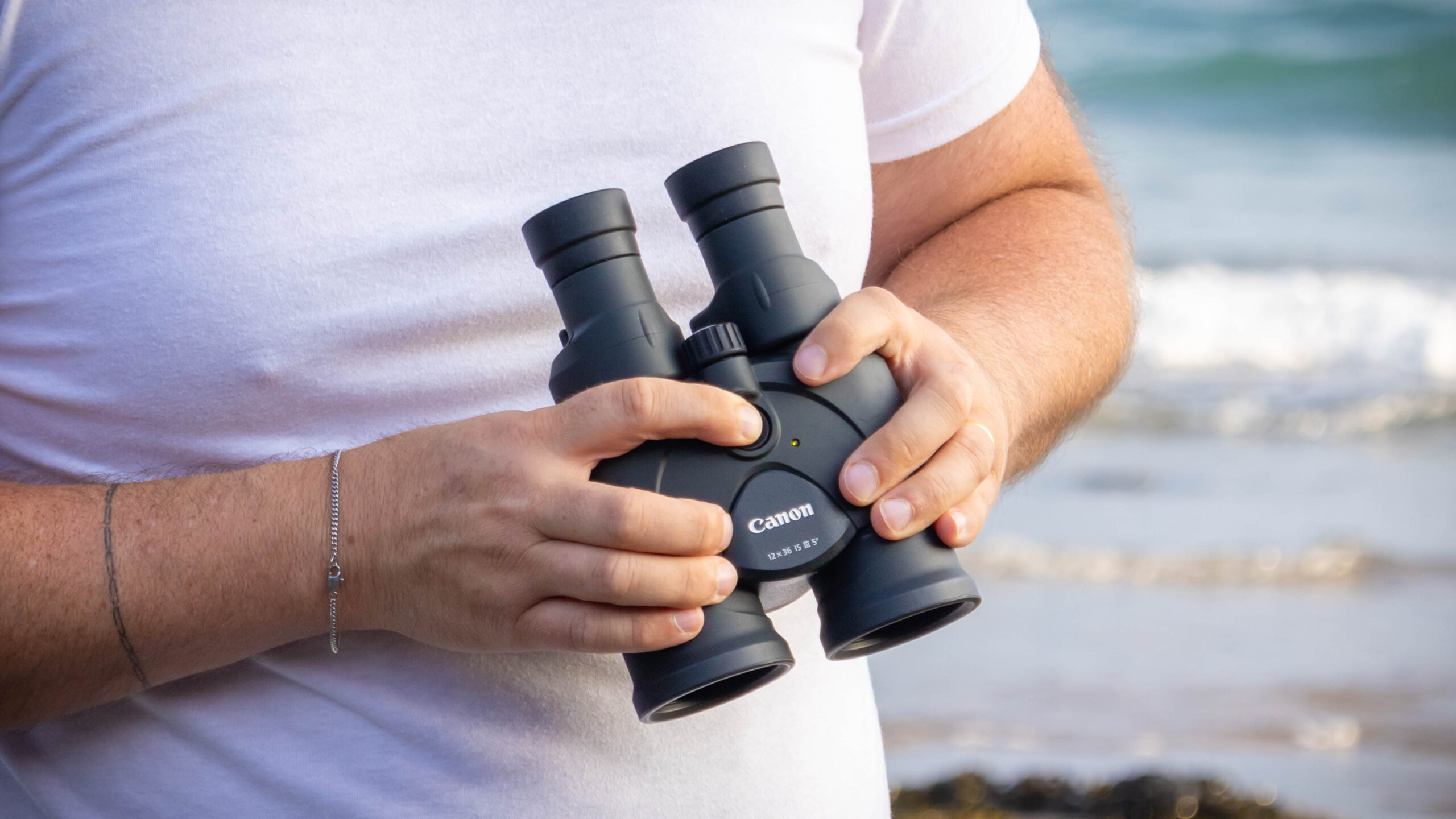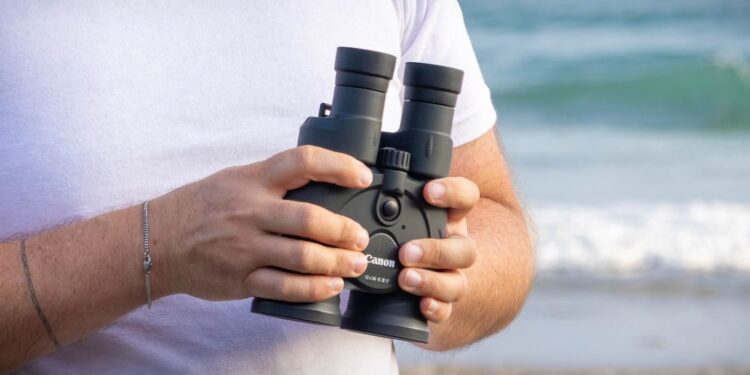Although the specifications of the Canon 12×36 IS III don’t lend themselves solely to being a great stargazing binocular, the 12x magnification does allow for good views of smaller objects, which is great news for stargazers. Due to their price point, these binoculars are probably best for those looking to do some amateur stargazing but also wanting to use these binoculars for more general, and daytime use.
There are many features that make these binoculars worth investing in, one of which is the fantastic image stabilization. In terms of stargazing, the IS allows the sharp views of the night sky to be held steady, helping you to identify the stars or constellations you may be viewing.
Canon 12×36 IS III binocular review
Canon 12×36 IS III: Design

- Dust and fingernail marks easily mucks and dents the rubber coating
- The Porro II prism design is leaner than traditional porro binoculars
- Operating the image stabilization is intuitive and simple with up to 9 hours of life
The Canon 12×36 IS III binos are designed primarily with wildlife in mind. A smaller 36mm objective lens diameter doesn’t strictly drink in dim starlight but the 12x magnification does give extra reach for smaller subjects which, in the case of stargazing, is particularly useful.
The binoculars feel durable in the hand and there’s a definite premium quality when holding them. A solid body underneath a fully rubber-coated armor means that they should stand firm against a few knocks and bumps. They are matte black in color which is good for stargazers who need to protect their night vision from lights and reflective surfaces. Plus, the objective lenses themselves are recessed into the body of the housing, further reducing light exposure across the lenses while in use.

Specifications
Magnification: 12x
Objective lens diameter: 36mm
Angular field of view: 5 degrees
Eye relief: 14.5mm
Weight: 23 oz (660 g)
While not lightweight at 1.45 lbs (660 g), they are comfortable to handhold for long periods when stargazing. It’s easy enough to pop them down in between using a telescope or camera to image the night sky and pick them up again when you are ready to do so. The stabilization is so good (more on that later) that we do not feel the need to use a tripod. Thereby, reducing the amount one needs to carry to dark sky spots, which is always welcome.
The flexible rubber eyecups are either fully protruding or tucked down, bent backwards against the eyepieces. This allows for 14.5mm of eye relief which is just acceptable for eyeglasses wearers but reduces versatility compared with other models that have multiple ‘notched’ sections in the twist-up designs, which I prefer.
Canon 12×36 IS III: Performance

- Flare is reduced thanks to recessed objective lenses and coatings
- Eyecups only have two positions
- Image stabilization helps with stargazing
Ordinarily, I would recommend the longer magnification binoculars like this with a caveat that you use a tripod but due to the stabilization in these binoculars I do not need to insist on this.
There is nothing more pleasing than using a pair of image-stabilized binoculars that are smooth and dependable and the Canon 12×36 IS III binoculars fit the bill. Image stabilization is key for holding views of constellations still, enabling you to suss out which star you might be looking at, or for searching for nebulas. While I was viewing the Orion nebula (M42), the image stabilization didn’t disappoint.
Unlike other binoculars that have a twisting function for the eyecups, these Canon’s have eyecups made of flexible rubber, meaning they can be placed in only two positions: Flap-up or flap-down. This is important to note for spectacle wearers. For those with limited dexterity, it is easy to flex the eyecups around the eyepiece lenses. However, the traditional rotation of the eyecups to adjust the height is my personal preference. The rotation of the eyecups to adjust the height is also better for eyeglasses wearers, as it offers a more flexible approach, allowing a user to get the right distance from the eyepieces with minimal vignetting.
With the objective lenses being recessed deeply in the housing, the glass is protected from scratches when placing the binoculars down on outside objects such as rocks or sand, for example. This might not be much of an issue for stargazing but is important to note if you plan to use these binoculars for general use, too. The deeply recessed objective lenses can also help with stargazing, cutting light from any light sources such as streetlights, if you’re stargazing in an urban environment. The super spectra coating also helps with flare and ghosting.
For stargazing purposes, chromatic aberration (color fringing) shouldn’t be an issue as I only noticed this when the edges were highly contrasted, such as dark birds against a bright, overcast sky. Furthermore, the views from these binoculars are sharp from edge-to-edge — this is down to the field flattener lens and the Porro II prism design.
Canon 12×36 IS III: Functionality

- Intuitive access to image stabilization
- Focus wheel is smooth making use easy
- No lock for diopter ring but it’s stiff enough to avoid nudges
The image stabilization is intuitive to use, with a button on the top of the binoculars that turns it on and off. This varies from other binoculars I’ve used and tested, where the button sits in the center, in front of the focusing wheel. The placement of the button on the Canon 12×36 IS III’s is ideal, allowing you to adjust the focusing wheel with your index finger while pressing the IS button easily with your middle finger.
The focus wheel on these binoculars is perfectly balanced, not being too stiff or too loose. This means it’s not easy to knock it by accident during observation, which is a bonus. Furthermore, the focus wheel glides when you do use it, meaning use is dreamlike. For binoculars of comparable sizes, the focus wheel on these Canon’s is small but I assume this is to make room for the IS button. While it initially feels odd to have a smaller focus wheel, if you’re used to other binoculars, it makes sense when you’re used to using the IS button.
For binoculars that cost $800, I’m surprised not to see a locking diopter ring, especially when I’ve seen competitor models of a similar price offering this feature. The overall build of these binoculars is impressive, including the battery compartment that feels solid and reliable.
User reviews of the Canon 12×36 IS III binoculars
User reviews are extremely positive with an average rating of 4.7 out of 5 across online platforms. Positive feedback includes praise for its durability and build quality. Users note they are good for use at night, “In night viewing they are great for the moon and constellations”. Criticism seems to lie only with the lack of objective lens covers and price.
How we tested the Canon 12×36 IS III binoculars
Tested over three weeks in the summer, I tested these binoculars for wildlife spotting in the countryside during the day and at twilight and for stargazing in and out of the city in areas with Bortle classes of 4-5.
I started tests with stabilization disengaged and relied only on the quality of the optics for judgment. I looked for barrel and pincushion distortion, softness around the edges of the image circle, chromatic aberration around contrasted subjects and ghosting or flaring from the sun or nightlights. Remember to NEVER look directly at the sun, with or without binoculars.
After testing the speed and smoothness with which I could operate the focusing wheel, I then moved onto the image stabilization itself, noting how steadily it can hold views both vertically, horizontally and moving diagonally. While observing, I shook the binoculars to the point that the stabilization failed and worked backwards from there to determine optimum speed and movement for tracking subjects. I also used these binoculars in fair and inclement weather, but not in heavy rain or snow.
Should you buy the Canon 12×36 IS III binoculars?
The 12x magnification makes these binoculars truly fantastic when compared against more generalist 10x models. The image stabilization cannot be faulted whether you’re using these binoculars for daytime or nighttime use. I was able to view the Orion nebula and other constellations while using these binoculars, with the image stabilization helping to hold the sharp views steady.
If the Canon 12×36 IS III isn’t for you
Related articles
While not being the most cumbersome of binoculars, depending on what you want to use them for, some may find them too large or heavy. If you’re looking for something more compact but with image stabilization, I would recommend the Nikon Stabilized 12×25 S binoculars. While they are visually pretty identical to their non-stabilized counterparts, these Nikon’s are small and light. However, the views are not as great as these Canon’s with slightly darker views and softer edges.
The Celestron Nature DX 12×56 binoculars will offer you a bit more reach but no image stabilization and might be just what you’re after if IS isn’t high on your priority list. With fantastic build quality, my preferred twist-up eyecups and rubberized armor, these are a pair worth investing in at around 25% of the cost of the Canon’s, at the time of writing.
